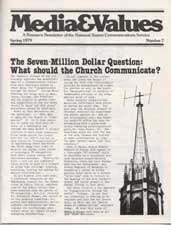New Technology: For People or Profit?
|
This article originally appeared in Issue# 7
|
A Media Call to Action
An ecumenical consultation on "Satellite Communications and the Church," sponsored last fall by the National Council of Churches in New York City stretched one's awareness in many directions. The program embraced matters as pragmatic as current communications legislation and as futuristic as training catechists for remote missions via satellite.
Satellite might be defined as a mid-air television "dish" positioned to receive electronic signals transmitted from earth and having the capacity to beam them back to other "earth stations" (receiver "dishes" on the ground). Potentially less expensive than traditional transmission which is so heavily controlled at present by commercial (network) interests, and potentially more accessible for remote areas hard to reach by ground systems, satellite communication is being viewed as a significant dimension of world communications for the 1980's. Several presentations dealt with legislation and public policy pertaining to satellite and other forms of mass communications.
Congressman Richard Ottinger described the scope of the bill he has introduced into Congress (HR l4046) which would allow development of inexpensive satellite communications technology and fund research into the application of such technology for social development and the public interest (including religious and values programming).
Of similar concern to the conference participants was the proposed revision of the Federal Communications Act (HR 13015), which seems to give over too much control to the networks and the "marketplace" (commercial interests) leaving insufficient room for public service, religious and values-oriented programming and public opinion.
Regarding international policies, Father Michael Dempsey of the Brooklyn Diocese shared information on the upcoming World Administrative Radio Conference (W.A.R.C.), scheduled for Geneva in November, 1979. Official delegations from each country will revise and extend international policy on "ownership" of the skies through the allocation of air frequencies for radio-television transmission. (The last such conference took place in 1959). Significant issues at stake in W.A.R.C. will be human interactive satellite options, Third World access, multi-beam satellites, and the concern over cultural imperialism which poses the threat of a new dominance by First World Countries.
Consideration of the human uses of media technology and its applications for the religious sector generated reports of what is already emerging as well as some creative brainstorming about future possibilities. Dr. James Alexander spoke strongly to the failure of U.S. churches to keep pace with the growth of communications in society, with a resultant falling behind in the growth and influence of the churches over the past ten years. "The power of technology is a power to create," Dr. Alexander said. "When we give up that power, we cede it to others. The churches have stood by and let secular (military and commercial) interests shape the new media."
- James Alexander
Cited as examples of effective satellite programming for human needs were the ecumenical Appalachian educational project, "The Other School System," and the Alaskan Health Experiment, by which minimally trained local paraprofessionals were linked with medical professionals via satellite for delivery of health care services in remote areas of Alaska.
In spite of such hopeful experiments, it was agreed that public service groups in general, and the churches in particular, continue to be in a reactive situation. They are "picking up the pieces" of the effects of communications technology instead of being "up front" to shape the policy and create effective human programming. The lack of creative sources for alternative programming by Christian communicators was lamented repeatedly throughout the conference. A need was cited for the churches to foster the sense that artists, writers, and producers have a significant contribution to make to the Christian ministry.
The range of participants was in itself an interesting statement. The sixty-five registrants included just five Catholic organizations: UNDA, Passionist Communications, St. Paul University in Ottawa, the NCCB Committee on Evangelization, and the National Sisters Communications Service. Fourteen of the participants were women.
This ecumenical consultation certainly underscored the tremendous potential of the mass media as an avenue of ministry. There in urgent need to offset the non-values of materialism, consumerism, and violence with programs espousing peace and Christian values. Both radio and television pieces dealing with human development and general culture night serve as effective linkages between First and Third World Countries, but they have yet to be created. The airwaves make possible massive audiences for the content of justice education, evangelization, and presentation of the deeper truths of life through dramatic and artistic productions.
At a time of diminishing personnel, the Church in general and religious communities in particular might well take more seriously opportunities for ministry in mass communications. The media presents a way of maximizing the impact of a single person's 'preaching" — whether that takes the form of direct delivery of the gospel message, dialogue in the public forum, formal or informal education, or the subtle creation of a values-oriented dramatic script.
It is becoming increasingly obvious that one's impact need not be confined within the four walls of a lecture hail or classroom. Radio and television have already become pulpit and values conveyors, but the content of faith is mission. Given the level of education and the creative gifts of American religious, communities might do well to encourage interested and talented sisters, priests, and brothers to move in this direction. Some collaborative efforts among LCWH, NAWE, NSCS and similar groups might heighten awareness of the potential of the media as a valid, authentic-and much needed-ministry.



